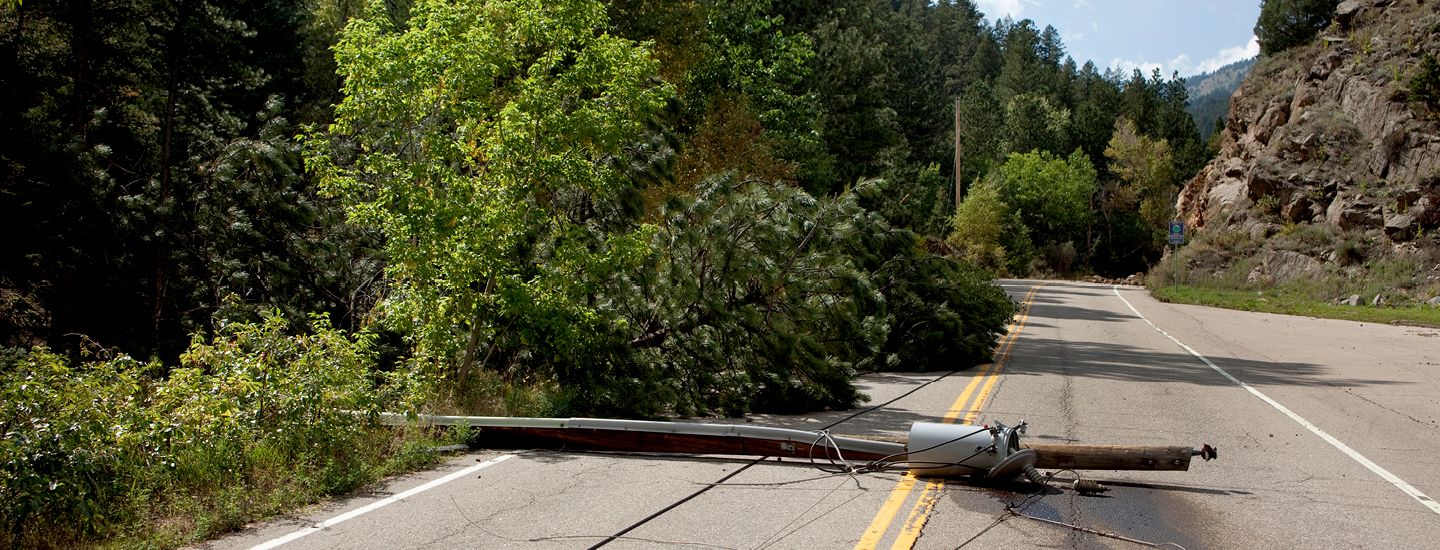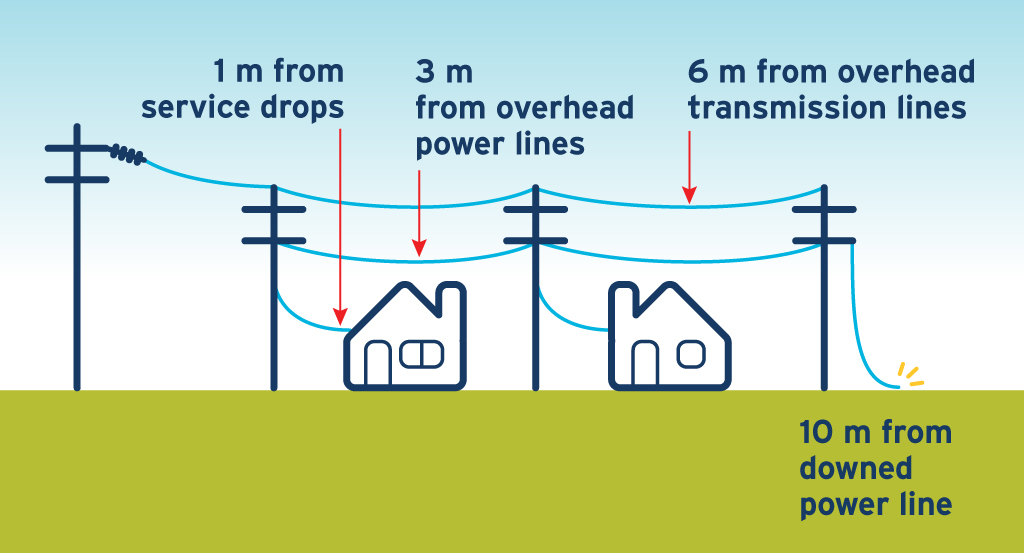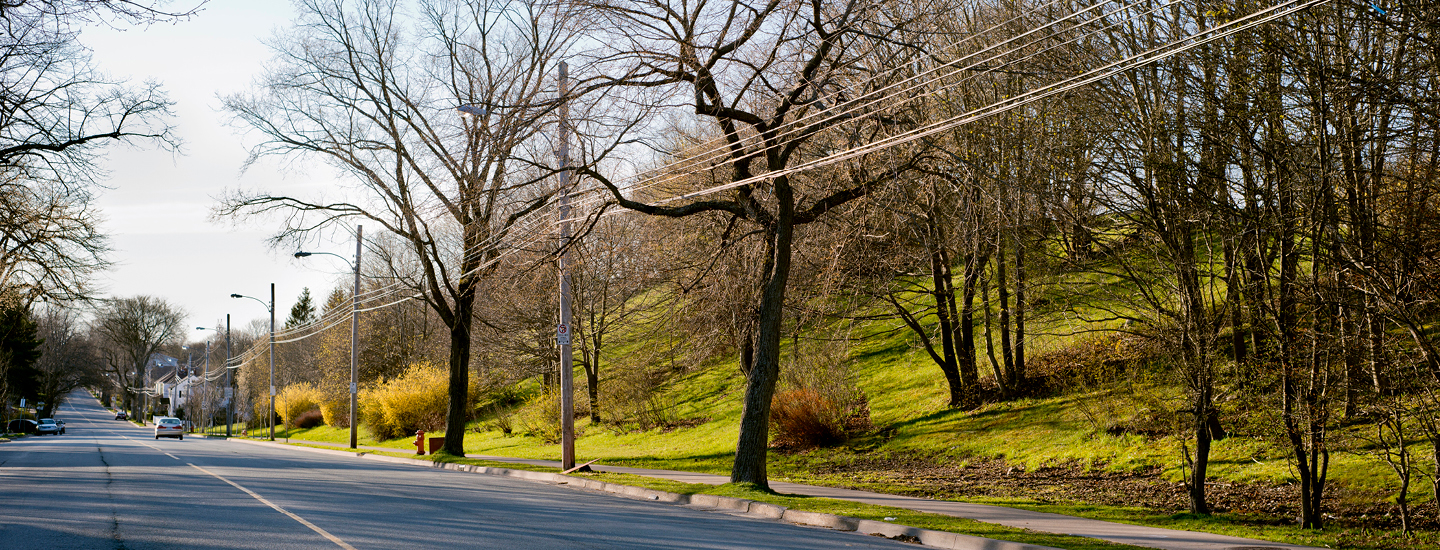Power line safety
Electricity is silent and invisible. And while we use it safely in our lights and appliances, it can be deadly if electricity from a power line finds a path to the ground through you. Stay safe by keeping your distance from power lines and watching for hidden electricity hazards. Here are some tips for living and working safely around power lines.
Report electricity emergencies and hazards
If you see an electricity hazard or a downed power line, stay at least 10 metres (33 feet, about the length of a school bus) away and call us at
Downed power lines can be deadly

Even if it doesn’t look live, a downed wire still carries power that can jump a distance.
If you see a downed power line
Stay at least 10 metres (33 feet, about the length of a school bus) away and call us at
What to do if a wire falls on your vehicle
If you’re involved in an accident and a wire falls on your vehicle, stay calm, call for help and stay in your car until help arrives, unless it’s unsafe to do so.
If you must get out, be careful, as you could become a path for electricity to the ground. Here are some steps to follow:
- Open your door and prepare to jump clear of your vehicle.
- Jump out and land on both feet. You must not touch the vehicle and ground at the same time with any part of your body or clothing.
After you land, keep both feet on the ground at all times. Keep calm and shuffle along the ground with feet together until you’re at least 10 metres (33 feet) away from the vehicle.
Be aware of overhead power lines
Whenever you’re working outdoors or up on a roof, always look up to see if there are any power lines nearby. Remember that electricity can “arc” or jump from a power line across a distance, so make sure you keep your distance:
- Stay at least one metre away from service drops.
- Stay at least three to six metres* away from overhead power lines.
- Stay at least six metres* away from transmission lines.
- Stay at least 10 metres away from a downed power line.
*Note: transmission power lines (high-voltage) look very similar to overhead power lines. Therefore we recommend you stay at least six metres away from any power line to ensure your safety. If pruning or falling trees near power or transmission lines, please see the WorksafeBC policy.

Working near overhead power lines
- Don’t take a chance with your life or those of your family, employees or fellow crew members – remind others to be aware and keep yourself, your equipment and ladders away from power lines.
- Look for wires hidden in tree branches or vegetation and stay away from any trees in contact with a power line, as anyone touching or standing near the tree could get an electric shock. Call us to report the hazard at
1-866-436-7847 . - If you’re working on a roof, always keep at least three metres away from overhead power lines.
- Metal equipment such as tools, ladders, pipes and cranes can conduct electricity, and they don’t have to touch a power line to be energized. Keep yourself and your equipment at least three metres from overhead distribution power lines and six metres from high-voltage transmission lines at all times.
- Be careful with irrigation pipes around power lines, as both water and metal can conduct electricity. Look up and be aware of overhead power lines when moving them, and store pipes at least 10 metres away from any power lines.
- When moving equipment, have someone watch and warn you if you’re getting too close to overhead power lines.
Trees near power lines

Whether along roads and rights of way or on private property, trees near power lines have to be maintained so they don’t become a hazard or cause power outages. Some examples include:
- Trees growing too close to power lines could fall into the wires in a storm.
- A tree or a large branch falling onto a power line can tear down the entire line and break the poles holding the line in place.
- Trees coming into contact with wires may become energized, creating a safety hazard for anyone who touches or goes near that tree.
- Trees or branches in contact with the power line could cause a power outage or start a fire.
Trees and power lines on private property
Property owners are responsible for maintaining trees near secondary power lines serving their premises. In other words, you must ensure the wires from the street to your house remain clear of trees and other plant growth.
Plan ahead when planting trees
Here are some tips to avoid having to cut down or trim your tree later on:
- Visualize the tree at its full size height and width when preparing to plant. As it grows and reaches its full height, it may present a hazard if it grows into the power line.
- Plant large growing trees where they will be a safe distance from the power line when fully grown. Consider wind movement as well as the spread of the canopy.
- Before you dig, click or call BC One Call to find out where gas lines and other buried utilities are, so you can avoid planting trees near them or damaging underground equipment. This service is fast, free and required by law.
Hire professionals to prune trees near power lines
Only trained professionals should trim trees around power lines. Untrained individuals have been seriously injured – and even killed, in some cases – when they attempted to do this work themselves. When having your trees trimmed or removed, you can arrange to have your power temporarily disconnected or wires temporarily removed by calling us at 1-866-436-7847. In most cases, there is no charge for this service.